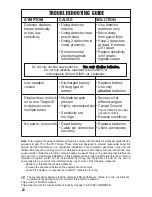
GROUND (continued)
The Ground setting is the only user setting that is not saved when the detector
is powered off.
The user's manual Ground setting carries over into the DISC
2
, DISC
3
and
DISC
4
modes, but does NOT carry over into DISC
C
,
J
and
A
modes. In
DISC
C
,
J
and
A
modes, the Ground setting is fixed at 82.
DISC LEVEL
Available settings from 0-59. All targets with IDs less than or equal to the Disc
Level setting are eliminated from detection. For example, if Disc Level is set
to 39, all targets with an ID of 39 or less will not be detected. By design, the
detector does not allow highly conductive targets (like silver) to be
discriminated out.
V-BREAK
®
This is a feature that allows the user to change the audio response of certain
targets. V-Break
®
allows the user to program the detector so that any target
with an ID in the range of 0 - 69 can induce a LOW tone.
Examples:
The user sets V-Break
®
to a desired setting (e.g. 42).
Every target with ID less than or equal to 42 induces a low tone.
The audio response of targets with IDs greater than 42 is not changed.
V-Break
®
can be set only for Target-IDs that have not previously been rejected
using the Discrimination or Notch functions.
NOTCH WIDTH
As you press
or
when adjusting the Notch Width setting, the blank area
you see across the Conductivity Arc represents targets that will not be
detected. This blank area is the “notch-window.”
Notch Width allows you to set the size (or width) of this notch-window, which
can be used to “notch out” or “notch in” targets from detection; the maximum
width of the notch-window is 20.
NOTCH
After setting the width of the notch-window, it can be moved around using
NOTCH. The setting you adjust corresponds to the left-most edge of the notch-
window. It is not possible to move the window below 20; iron (IDs below 20)
cannot be notched. If iron values are eliminated with Disc Level programming,
they cannot be notched back in. Notch can be used in DISC
2
,
3
&
4
modes.
15
MENU










































